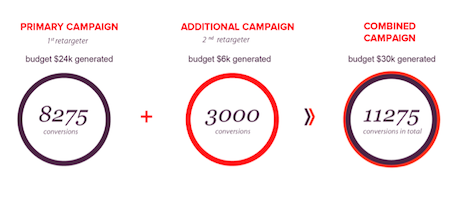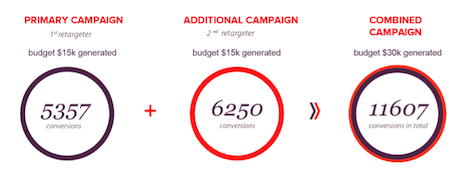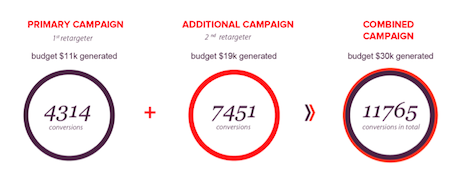By Daniel Surmacz
Real-time bidding (RTB) continues to become one of the leading ways of advertising, and spending via this technique by which online ad space may be bought or sold in real time, is growing.
Greater investment requires an answer to one of the most important questions: “How should I divide my marketing budget between different traffic sources to maximize results?”
It is especially important for professionals who cooperate with more than one tech provider when running online retargeting campaigns and have more than one goal in mind when managing advertising activities.
In this article, we are going to examine how to establish a proper retargeting plan, whether you are on a strict closed budget or an open monthly budget for advertising activities via RTB.
Option #1: Closed budget optimization
Let us imagine we have a closed marketing budget of $30,000 per month. We decided to spend it on personalized retargeting activities – campaign in which ads are tailored to the behavior and preferences of particular Internet user – and have only one tech provider generating 10,000 conversions for $3 each (Retargeter A).
To diversify our retargeting efforts, after a while we decide to add one more supplier (Retargeter B), but still keep retargeting ad spend within the $30,000 monthly budget.
For the second retargeter, we will start off by allocating $6,000 of our total budget. How does it influence our results? See the case:
Step 1 – Budgeting
 Step 1 - Budgeting
Step 1 - Budgeting
Step 2 – Results, rethinking and relocation
We have got our first results of both providers and now it is time to make performance-based decisions for reallocating the budget for the next month.
Remember that the higher the conversion number rises, the more each conversion from the same provider costs.
It works the same as advertising in search engine marketing: If you want to achieve more conversions from the same source, you need to invest more in clicks to get bigger amount and higher conversion possibility, what in most cases means higher cost per click (CPC).
If the cost of conversion from the second retargeter is higher, it is better to withdraw a part or the whole budget from a less effective source.
In our case, however, we see that Retargeter B has a much lower cost of conversion – $2 versus $2.90 – so we should still consider moving some of the budget from Retargeter A to B.
See what happens if next month we allocate our budget evenly by adding $9,000 to Retargeter B:
 Step 2 – Results, rethinking and relocation
Step 2 – Results, rethinking and relocation
Step 3 – Results and reallocation (#2)
Retargeter B still has a lower cost of conversion. This means we should continue to allocate more of our budget from retargeter A to B. Let us see how moving an additional $4,000 to Retargeter B influences the final result:
 Step 3 – Results and reallocation
Step 3 – Results and reallocation
Our conversions have steadily risen with the same maximum budget used throughout the process and now the effective costs of conversion for each traffic source are similar.
In other words, we have optimized our results by reallocating our maximum budget across the most effective conversion channels.
It is worth adding also that there is a huge chance we have achieved our maximum, so further movement of our closed budget will, in most cases, lower the number of generated conversions.
Option #2: Open budget
This process becomes a bit more complicated when you are operating on an open budget.
However, in practice, this can be simplified by thinking of the closed budget scenario and applying the same conditions.
It is all about managing your results from each traffic provider, and optimizing towards keeping the average costs of conversion similar.
Adding second retargeter
Initially we had one retargeter (A) which generates some traffic using a CPC payment model.
The new retargeter (B) brought you more additional users and conversions overall, but notice that some of these users are accessed by both retargeters. This can make the final conversion results a bit fuzzy.
For instance if the same set of users is accessed by two retargeters, but the last-click belongs to Retargeter B, then it also has a very high last-click conversion rate.
 Adding second retargeter
Adding second retargeter
Retargeter A has the same number of clicks as B and it means that, if we use a CPC model, we are generating the same campaign cost, but the effective cost of a single conversion has now dramatically increased.
Retargeter B looks like it has a lower cost of conversion, but overall our retargeting costs have increased. Not good. So what to do now?
In the case at hand, you need to modify the terms of cooperation with every tech provider – for example, the CPC cost – in such way as to align the effective cost of conversion.
It is a little bit similar to moving a closed budget between retargeters which we described in our first case above, but instead of modifying budget limits you need to focus on adjusting limits of effective cost of conversion.
Both options, closed and open budget, can work perfectly fine if the campaign is well-managed as a whole.
MULTIPLE RETARGETING channels offer broader reach to your audience and provide flexibility to optimize marketing goals.
To make the most of a multiple retargeting approach, it is more important to establish goals and pay close attention to results – and then tweak your campaigns based on those results.
Optimization is ultimately not about the number of clicks, but about maximizing return on investment.
By calculating the costs of conversions among multiple traffic sources and reallocating budget, you will begin to move towards your peak optimal display strategy.
Daniel Surmacz is chief operating officer of RTB House, Warsaw, Poland. Reach him at [email protected].
{"ct":"q8bjx+YbPoJ5TMrozfPvjhXdWhTLLDArQhfrg4zdraYTyYvwQ\/lkztkDBwtV6JuRap8gk184HrzOTl3riGc8ashk0b3EF+SEuz6iLUM\/QLr6jOcZO0twNPjcUuJMd7yl\/JpA7TYxlrXiuliBmvNOEQv2vmyIuA1o9b8mAw7s6YNMiMC92dXY70w0aJP3N0RFxFxgOczOnmBihAtbiOITsskC6bzTj2qWF0HcFspB80CsRPVeh51cLrGVh2FFXEfPVm5tdpVoxWfLlTf9H2fv9hoKXUeMRUoGE9g+gkjB+E87TJH6+foEgdNuYoNHw5Xh5fUUo9zGLgAFjW\/0zW+QAUVFNtcW3euAVL2BwXtzcgnw\/iS\/1gBz1pv8JnmWg9M1ZZYr8nPjGwDmdjkvLlnXTGBKY6slibFDe3j+6WcLvcRBdS6dL10joUEIVlbmy9iOcrs2WhMXlDhJJAn4TGZLqpu0wLzp8oXDQqVltcgECdNs4Bt1ukKHpq7l6GaQH0ALGqgSr2LvvX5Trk3Dg6wEUA9qW7sBibZRx8Zia1TXBxWEkvc6PUKSEGvhCSE9dp0V609SMPHaMoZ52MJ4v1CLENXxDRxNxYmySoFNjCPPsDyh+xy1MUr8TXaq8hi\/QoY7y3yyXsGIVXQBqBaHXJgfId92Z9cAQ\/zYZSZ04eIBIlVDVUaDzFjkG8xUT8FVXQWuPdsQhR\/dJdL50i4+forlHz0NsPcIDBrsH\/Q5ylnY9PfN4fA6\/ze4cX+MA8o336SIk7W7rgK0ow1liB+vA\/JGZS0hFvMA\/EenbjPLORWekyKAIV70W1OFz5Xbx7ZXQCbOa9equyG0hfYfnIype1tehUgOEI2iSd56bmgps6WUqLDjcxb0p1OvrJ3rn6ZMIIsYCHmfcn1om98rr1Om\/z5vQhTuF1s49FbemTI9p94ZnYJqlJmjqxTIczDr+Q+vjqheVSR+DWR3qLYmgGFUFSz\/fRAAWdLUcNpnJhneIUroJa3iwYVQQHHWqeQg+ayLAv68uWbODW9qn5HC2LGRCbVIh9t3xE01pjnzWfR4WVHXlBqmZNYRGQd2+GPHg6M6KvYYz0XTcb6cwQWTV1q5IYirOpClVx1p87prEJk5xu8AyPILPqVIBqjnhQCxLt4Dg1LJNIDnXaDZYPsxSzrnJWUAocJzeT+aQtKZnokPVYXlygOxU9rJugiCOs4iCyUAdi\/jDPvoAE2PiZV0hilcL7INGZKlIpLxKs62ZUVPW1dB7mbMq7QFhnPj\/DGtnOTB4xx2uRFi0OtZfHNIltqect5c5Bv7FKaSeM3FI8KJSLg2mSRDGZB\/hVkmkJnRXIAzY2rexRR1bpYheeB+SbqUTO3I3UHnzLQ6EcY501xzjEgI9FitCrOBP\/LbbLyrlBScsws5FgBD5m\/VLc6ewTjbvqaxUwdMmTdjeoGCyRJjNwSLvzbRqPc8LxYBJjUwAPrdbO1xA+7ge66uetVi3\/tVALj34HKXfiDwxJYJRHX\/s7\/zAhSvSDy\/mvUoDGUGxzL2TdYP+NkqUbprinUCt5v7E13hnKKoqOd8mYwnCIDMI4HbU19MBC+iBHw0jFLyLSBfKijsEVPyhp+pINbFMzmqTpUQRcwQ4C9WCktSOZfLeNlSwVB2s4MaDtEPlGjhurvl6lrtuc0hD0TGFsHJThIUtW3EvxVgATWpFL04DVnwNL8wX073WmGFYauo5VL+2oNULAhinV6XdydaA5tjtu2pyvIXGHvGQVlS4\/lylYhKKmeR458Rl6SQWwU9fmnGsK15\/qrylnSzYFFYV5IUbFhVbNW4p80uRUTX6tSYwU2GFD1+XB8K3RHw\/jQnN05s0oQ926rsSFTOjCnQvuGcnVwbVqDK\/kgTUi86ZFPRDbpHID04BiKwYJ1d9+4SaCwt9oiNIHm1aEt1zr4gZk\/GHPmAmjPLsTIagiVOdwJulwsOfKSANGd6IlbqtQPJWCG4HG5Qo2VCrqp\/ow3eV4WJWHmBx1J\/7clm8O6Pi3ubrztcKNgp\/+wwWdAQCu31PoAtgtFLy7BrRDSR9rowm3Sd+QdQda8B9DPtTAzvx4FaOkFExS6U3R3QoA8V5EfyIsxjOYG6nq71E5r4d8nFAnNWDz1SpCmc3C8XMvodTKkX\/IPb2\/uve6jVK1T\/Urd4IHVBB7BTQ6LyhPNO\/THtfIsNlA9Eh0mq+dLYvJ\/yaifsJixMjq3BVMGPuiSwkV+fxNS3NbF7Yr64HbMUDZezEZN0G5QN78EGWVfY5iryW8nrf1a8b3KWRs22gRU4GKJXGC34FPWmVmDg\/\/YD1wP9nDirWrj6Eh4bN7MOFcI8t\/Oca60I\/le82AXg1bGthrd78hNHqQzlbdlWPjY5sf0+kWBVl\/JvIDKciZY0cO3FFeZiiPT9We+9JUdh2UbnnuIj5AKZ2DQak8+Oj99V60Hb4c2OwWnkL69NsKs2JPQ7oSQlrmIfQh4ccq+VMwqiDiEwrcOm6PW8YJiGjQfcDM3x5bfH70vsLAWjwwkBRPucQ8HWaz+B+\/Na8b5mCgPBD9ckDF+FbAd7kbsgpZ29Jjd9nGf23lVw7Z7RXnpHSWuPYxiffNBsGHYdX5hZt0B2qDsGrzJNarDyk703BbUE7J8vr5hWR16G24I\/cRqaI8H8KRpHRV66pMx27UxvMo5W34l\/xxTWnTl3gf7L9YVUULlPcamc0AUHPWzLIUkSWPQA44iD9MM+V\/6zRAc8Quh5zsVAv7n\/+mNsTb0PqvYZ8nut699VuFVhP9Hdd11A5Fz24e+btDWqMBobMTB2BcQmYVVZEzFrb3rhYz6nzlQOfzF0rHAhPTYh\/B3wV5crHoYb6DRWi8nn4QJ3qXQ4dVVLJvuTaBcTAQe5ffid7+L\/X8U0bPVVS5F8MSANo0RwCHy5LKNzghC\/EZ3+nS1a3OXDv5nCZmo81hhc59pCe+tJyBHYjbXwzz0i72AMZg\/RujHvpnqHVqmg1oFB8PRD1wlbcZkkYv2yTBv8f72rKdT3Xmz3cKr7xSRVbS7VLIgbJiECSr27R5cNV7YnO3PPx1wpDRGfOxpY+DF\/BaYRyJDUBqMZjSQFQJhvptIcis\/4ptFhBOE5wBnbT2\/4HVD+XyPdrC4qcQG4X8KzDDTmRmlGddsYbxqSQjFK27i1nHqkxeTKVqcptglrf\/MK4a3owAcQPuSnplUWHWQL7nZThgWj1hiNn4vOBw+sK1\/iMWo9Hc+UbLNw+xZ5DvEq+qB2hoNPzhFFnBkVuRWJvi4YkOvEQGppKn28\/RL2XP6g36e6eABp11rv6wDpbtEclA9LW\/WQSBf6z52bnWRmtJFLOoLxcHVHGl\/EtqdjWrqoXSN1013IhieOkdzqWpeI9Y8XyNwDerC3UE81IUua\/c+ceLEJpeNOjUaNBc2dLLiwT+m1ty4SdwZMdIHmUU6HpQDj+\/NDtAXa8wsv5MELgUrRgV53HNK+AMzYkCRby7U\/N8lgSsKCSYjmldli6Q3hTwx35g2uVIdPoSnjbc7ALFkuWSzlZ+aUIJHtL4D510O0VH7ji\/ByalpSsZJRq6cJGl8YYQ6sDAU0KoskuiVB8Uf0iXlDd0mtEuLNF7XbZ+xDfgcTMK7XluJCV4OOGecD4r3lPvXIg0kI9itaPRHFnxmqwcT\/BxN6wMyjz4e+I4WPw1FgOfVErrGD0i5aNBbEm+c0nftopLNGj\/2TN\/bwpXoVvhZ0\/2kU3ck1Hofl60zlG19fpoe41ryuz8rDoL5vpClX9ExEDrgNoLH9+UHwWxvffhDY68m6vWzl6PQ79tMgtem5ZBn2NyEbnOhNCIEo5XsyLzNa5wEk4g9xw8Mmvvt6ArKhK90UBWE\/WtDW8UnqC9fPKMrSnwxm4zegNbZVwEI0anyFloQoW3cdmjQJVthYBR3qBFnq4ont1z5KuAa2nH3naMN0y0e1SIHosTNOr9A\/0l9T8fu3vzbmYJ0Or9vNq8XHFP8T3ZfdV99AgBs1EMizq\/1DsH8XundL4LOyOAQI78M8WCG58L7O9aYbxE5an2ag69hcQ9iVqrk6gLB7U1mE6iJXEmEbq+9zORcioSSslC8hkFGaswPxr3LnkUsxFhumJw1C2sE2p1FIpT85t\/kd7EQ4FMcgSAevxH7rzDZAAQVumHDLK3zmyraNZTm09QL6ZTeOPyBFX+hWbkIIABOeEnS8puVBO3nNmrOMxET2VY8f3F\/kwkeCyqVq80I41QsPku80lu1fSHEV+lEKmhw9B+Mn8OumMCsLEztEyvT4IATzFmxKkPEgTi3kDle+xtNgP6ssw2xO6aRsAUS4m\/ivU57zz9Zr+5195CsUoPN90qBDObt632M55BFcxIYJhWPf2L8KM7DhpvEqxaPaHjKo65+KjPiyhZBNglCnQN\/EeDAfvjP2FcA9MSvNzVyhdUqzso77y2qSdDWshCYU5W\/xgdXH7ZscRuIFFUsJhydnHVlVRO1krJ9zlOoGz\/g0A\/4SUT8OQPZCGAcR4EwWJuMqjYc7BfQDua6m+r5\/AttmaxIGie0lYrqac3MHlXIZtaFK2XADsK8+oK3IF8TzanEE\/PSBaBPahrr+DY7NTB8GrPSO8uU\/kNLtbCFPH2PAMwUjJMepepJSCUhZjRRoBNjvWevJYX6Mrn7idWKlyQoA1JFGkozEPvyBcAZZruvduCqY\/LstnPBVVoV2+w0kPF8o79T4UmTMJfHQqsg1NZbttYRXkV7DkImMq5SZzFBBH71x6ZOFdnC3ggwD1uXy+\/iefrJ8JkW8ZST7NDqeI+GJrtXRi1nhP3LH4I5M4AgXmNnBPcZP0kP7M7Z70aUNt+eqMSrssL+5\/X8gwKS89OP\/Z3XuANMzMMQfH8XuONe06qbm0FQpTvMjBIb9vPThrwXn5JagpMXch6tF1hgvRABtKaz1LUnz+PzDyoZ\/KdYK0+fJogNU2r1fhyBO1O0IN\/WgnOkcbq3I2KPnpC4d1YEVC6Re8UkXoNyrgCq2mu90i6HZvP0oITxM4LOeyQ8tF42s3+AA0TN5wygar21bW24ww1gMKwgX9vHdt8GSuajqMVklK6wnpBLbECf0vm7dNNMuTLS\/k9XuL+Fqgx69A\/gxsociPmn9EDMTxHBlRCGSzTYaonbSWJQpwBS90if0IBc5vvUw37JYpsJb6O9Bp5xQBp1NZhKroHg6B73JWxlNXzSWrbQvvNNenMeM8WAAtRQkPISQ4LDqITegLscvP8YmqZNrAhWyIkyG2XIqKIYKM5tcEzpuc7jKJYehUJAoj3YqyMZpx\/ZiGABR8wXhvTdbsWvfaBpT+WsYyJFcyPSVo1201vHabpp1w01pcNOTdMVPxIN8jir2cu3Q8M6Pju1TNbOcpWTIPzDgHhZQ8Cy\/2mki94tcGWgoJDxrRpJo42BEb+F7ZfKZ0gMmHSdvHtNx3az1yC3PodPD5BpV\/3q6SVdHKr2yN145jnJLDO0sGjdZXTU5UK\/bDhq0I9q0S1Hw72SjOHA7aG\/jZUGEXO74ILaW5Mfq2yAy4b5TeuH2zDzhv6yJVDa2bJUyI8Y6FORPpwv1NP+ixsFQ0xN+\/7rC+f3B7ZsXudxcmr3eqaVOt0\/qEHM3XBayp3HXTddbTO8GMGENXATtaVgVTp3PJaHiqHbLYi1GBxg7Qv\/3r3akdlHY5qTeTbzq3throB2muDoeWZW8AG71tV5GHvW3O0TxKINSS1LkzgjLhkpsCpxeU2S5IOtFLSkJHIGRyDeAtIoNz5dHJBcUvgrcuET+fVL0grpMXzFLfMZh8gWlA0gSCw6Odr57oF+BvClFSHNvNKynV1ueMbSriGc80ZDI4kRp6bJ8lsjK2QuIhRM9SAlN9geeRlFPQZf5ET8z0CFhgV\/l4kqrMpNNHBs3In1AqnLDqf4vaw\/SC6nSzusXDE3SlihTYIP03hZxlkT1EvVW8zPXt1\/svGTfm8sovuGPO\/vBIAvBi\/0IvT++LvOPLxFpNb7mm0n7wVfgu8LIyDze0aHEoacV+SQAKg\/rAnzTS1oaQC1B4ogUuQBRz3QfesIXJYW8qkyZDIjMYYq+h5VSYTDu+FvxBk7ibiMLVJN2Ou3HWlmmvcHu680DwOnEmVWQPMl8LjSp08RAwhdffCNi++\/qov2aNH2z1klNSNwT9FD5jTGT38JzFfAHnJn13IEAhQ4linojTJQ2cmIXrvt9cn5ZruQ11JfhZTEwq7FXec9e+WbJQpS1Jk25HUIidbHXEygmpXQZhU\/qpvy2u2T4pSorqH9RZNLzxn4ao\/3nCZRB1OxWAeVNAYEkLW3tA\/W\/trbOJSTO4GpPGtk26nHITLzSjzV4Q7NI5\/Msv3gy\/wKCrd84EAF43pUU1Xb3EzWx6IG+NT\/uKa3vjfdIYaK8VXiO9HM9QN0Q0yw5+L4SQUSz8S3I+\/zjLcEJlHkE8p2PUxJmXH7kwS7XL5LlI6D6uINi1TbLIER8aMBfyNW8tICsQWRnb3++Hfca19wgkQR+9i\/GlxEmYW5dbI0NH+BPLbEAHLqJ7R\/x\/PlGMJ6GmI+HvNZmowvcqkaw1FrxadtPqsT9ysyed3FXYkZ9YOXKYCrskZjIPl66BijyreML34VROq2gttHqz7ifeg3LOmaD\/8tx2J1lSnigfP4pgJwJQg2Hsh1\/qg61PisVPrB52Wj6cbjYNJOqcVW3dgI989w416ktkedhhx8VgThlKoYf7E9u2mV2HZZpuwMfvPIGLho87YQzy5MtqVPEElmFBojB6hp+\/Pc37AydoBy8fq0MB48a5ykr\/1c3NSU1GOrfVSgREEFdt0GOAfvGAtImZpVueJUpFrv578AeSRO7EMM3tou5hKf\/THLd+S9W+JFrfYv6+q7Ro9Rjy9UazNFH7gPm6gx8ADrqJar5PFOjdYYMktGPk+H0dBRbQw23wWI1EhfAEJOmchvC7SO7tFhkccabmHEH11c8pCTcB1qz1lIZ3zd8K0EZVMaQBT9dqr0Q1uycD8cc+jLGGaYqSsMLUr1khfBdjEiS7BExmwCaxbpHoih8cMlNasHp7rl+kewRvPFoE9wT83Zq3tL6vb45UmBVAqg92rM2w+0LB3JGPX1plXONU19Nr47JmpI6E+WGAkYUUR\/UTDsAnohMhHgm6sLLWs7MjvNFN50RPZ\/868XS9kQjg2noU1\/U3E2wFpzA4uAWQnFYrx9wrHLUngeOPGkFSovta1VHm0v\/CuSJJW6DPzDBbmFwx0OOQnX4w2n\/y2vzvQcxlxL13Nfq0k921Z0H252goq0T2uMqH2t6otzUAnB+bqH7uTpz6105GDUE76HA4hrHGYG+QH+k\/RyB+ret67Bikzbn3hL+iIR8BIZbZ5nISSwGdtXkhQcsHI0\/R05LmVaFeHFAbKknUxSLgNVZqUY\/Yueb5+zd\/78T0Y1mIomc4zQGfvuF4C\/FkwPj4pEMzLoF7KWLkiMIPMPzFidTMua2zhTxxseoGzuRSCxmdOVea0sD+hl4bRta81CWFB0jqRIHQXtf468\/uMoLV2PrDEVRufz+LYG7yz2mVNGNE+H4V3sF5p5n5ZGkAh0mPyEkZH6oFLJHE55iaoVVFzJ5OSRXKUMO0KhCc53wyQmrhffKvhYHO786MN9nsqmIPKfh6C25c\/cITVBAa9r7M+Lmjkx8YwLtiwwwYZNMyONnkHNXYErWgqQufrJ4PSQSgMrYRhzASeDCppu47Nvl2Bsgm2deNz5uZFgOex96S1dkmQ5tqdEYeC1zP4lg\/k7PIAdjnQxrtTHR5amaGv+Ez68pQQJobs9PvdYXnhM0Qn3BTX1wluvEIsut7qioAoh1euQQN2uawSuJDED8shKFwEuicmXw15Ym122B2+R+PtSTv2ehbnmo9N02bMbtfg1+3zY1Ut1+jHDjwTlnBpq++o0atozTWTvxc8Pinl31A5MoVAF3NIyWTg5FWkMsThliWcHofrn534uECfL7\/BCCD5bWDtfCkQ3c6Mo4Pf\/ujtd2F9kDzQ1Yt6umf4RSyDKnvzbEYhrtY6MQhzaQ3m8kMoTcRmYOJ89xHkrcMs0SkLpeqLDI1Mfv7qTm6fx4zudvdIE6jyOUn\/Lk\/ZbM4m1t2CCCqq3Lq4+105v1Zzdhu+Xk4UrgeFQLOQE1D\/1oClaPpfSJDYqkVenpxyuixHL3AqoZfYO9I3V09MH2R5unbkXx7XG2g3UxaUJSvnnDKFSuaMT3u8EQlAQ82EcyfQXcPNOOvG+s1FM0llUT6J0\/yKx3YmtNrA2TgpwU4ju1k6bhaQD7tG8HYjo9HYqBSTOxLYIITzcBDpFAw\/tQnQvkKWu2MxmKQIJArLS6WhM26WFpMx1NEqqPPqDp\/2AtYUYLS3PBYLOieF1iLbbMFjFydeZH5z1NjjRewjLDPBFsQextcGHJQKKKG+R\/N1oENTf37OHonS0BXxbZq1\/v5LRpbX6Pmd6ToSW3tQlapHT8vrhbdwpfizfFOdWVyw2Fivmv2dY2f02zdu37lUptlPfijWs8g05ccp2WHz59fmrLPJ7JDUbxU8W71YwS39UeEWTL4cyb\/lBUoxD4ObTAiFWNdEmhVhWziyeJcbRzn9hGeExzlk7WkQVhUQPQelZL3kUJcuQQc4inJrj+srsQPgxOzTFN+c+Eyt4ola144+MmFFsA8GviHos14xxgAhaIhjzzANCsDGk5torgdPeER8Qejtr4YmwrxSj3Rnh5GQxmGEVPxCLtHOCkxvyHpwlf4mf3Dox+p5\/OMJLc3eFqZfz5ygzrJnh6Mx8wmLK16OcM\/qypcjaRR5D4O510AzzsqkHueGkQl1Rk5ZTpmOEoqy76yE\/\/huNtVwokAa1nBTPaNQI74D0+4wTBcwhvYFzV3XdNRCFsaBBAj6MXu7s02uaYipRy9O6xowtzx6EyQDcpb5oCR57ECenbQhX2tu\/aHQ\/q6mC+uDBRlUr2o6Y\/xOknhDLZj9yrbCeFjnGmFEiv1xo+LRoFImFBO2l8Rv3wAtethdcnv1KGEb4iBDnAyKOPAFPCwRTS\/tx\/GTCFp57G9G6NiLEbD3RUaGg4QkXaJcyc7i9JJEgH5gGOm6qCzKU39M5dfY0Z4626dAyDyKvqgw2oBtTQPRSN5jW35xfXraGL5PBRaSncVbiX5FJT1PZP7PuB5aEwaWiTPPtj8UHB3DmR87UwRHyH4PMkfMjWp73wANst94pVF9Vyotbj0p2kChWtk8IYXnQxNdCX59rWWcaAJvkIuUPOCCmHQiLgRYOBZLiSmOoOC4gYJUfnvMURfA4+PsNHnhRQB2fe75BZsqC8cWb+cFZg0fq0vOm3GMPPAyBfMGFLZamZwE3Yco2EGk8LkV1mk262A5rP2GzWm\/MFltijSLkQG34S6C89iGnJLkvcFCCHwfKq+NGvWz5\/APiuo02f+hnzfEGLD9HEFb9TzzXEGRBfRZ1p4WCXt586Q5POUPB1+XZXY+djIqHP1MyinK68IEfl8DW5sIdyvS3sg0AW063rcbKXP1AnANaEfHu0izcPK8Uwer6UOOetzEIqBJESBhhzh12x1wJegBGWRIRe4pTwMh3Qxe3WPCS2cMCQsc9w7rEEN5DZ\/D8IsE6+gPMnMo8pDH0IiETl2R0AnKfvyiIX4yqhHqDksQcFOamzDpGEJ0xAHT1En5fOurVl1MCz8NI4M5gFedPfp5iQDq+7IkmNjWXVUm8fTlgGeQmSV7noJMGrzoBdqs0hfrIFj5fpcPv2PLKTyVfvlLNs+Gx\/Xjo59Db4VmvwvRxLA+mbovesrjLktWtlFw0Ec8pYMRxDPKD2gSqJJdNbmO+JbTBRokICrHgNY56fE14tgGAnylE\/SsKgxVB3j4xq3VBOvepStWJYbvuEMjU8a88Gx97yfFcVsmEUjS6TUE4\/8FER7Ib51pjLVNGPTKfuFzsi4NvOrnR8yFsMqn\/xekNu6pwvw8dLM4Hj6KCCTfVxLxsGO6bqnnNKeZQEcQKlFsX9NOsUIK0hlB+ZHyqeIulJ2lsCPJNRGQ9YM09vPtwXJIhf2stDghznLiXwVmLSic69mATqbUhUNf3XmSoYwQhKTSmLrJ677MiOUuGmgnmgccA4cuJuBc5D7vTTZ1ppUggVLzBim6obtgmkWQGBxikX83a0yHVv7rVx7lEBQGkc7Hw84SUFpUvgXQc+Zavami6Fbj\/YAdlm1dxKFCqGahrnlOBEOabcOmIYClzMTSbiokR9\/wXQV48hI3LGsf2px5Ikt2Ebbl1vv0fVo78WURyDHrofLMlnosSL\/3tftfS47w\/qbrdiTawjmkPU4NG4uNmCA3X7PaDhsgPRHfzFZFvGazSe","iv":"b274a4836b375b31275e65b3d67ab5bf","s":"261930dc09c7bb80"}

 Daniel Surmacz is chief operating officer of RTB House
Daniel Surmacz is chief operating officer of RTB House
 Step 1 - Budgeting
Step 1 - Budgeting Step 2 – Results, rethinking and relocation
Step 2 – Results, rethinking and relocation Step 3 – Results and reallocation
Step 3 – Results and reallocation Adding second retargeter
Adding second retargeter